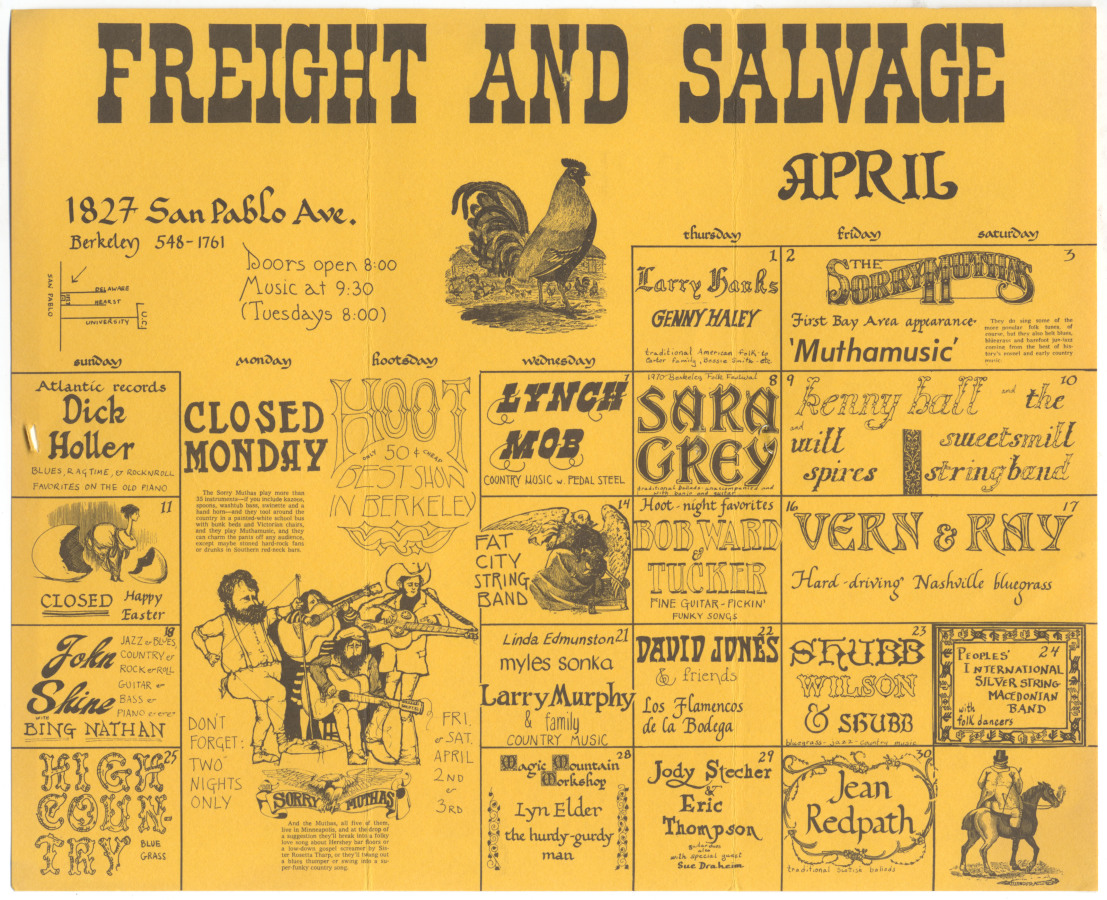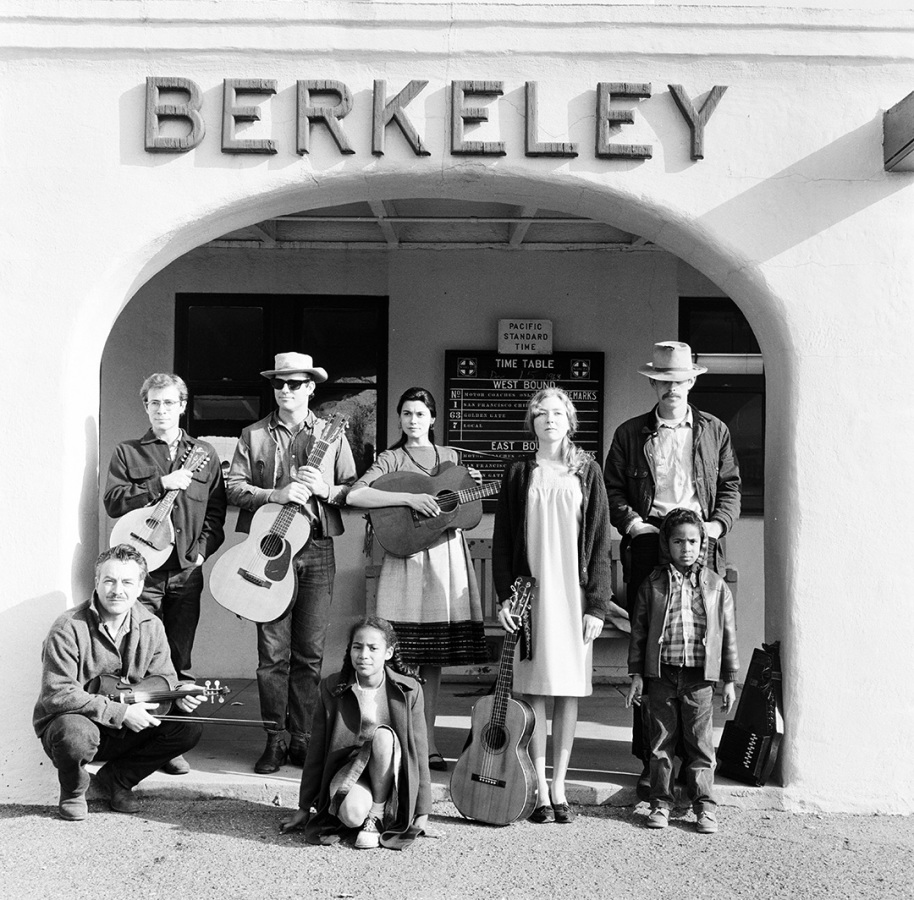
Subject Guide: Bay Area Folk Scene
Subject Guide: Bay Area Folk Scene
Introduction
From the late 1950s through the 1970s, the Bay Area was a hub of the folk revival on the West Coast. Venues like Ashkenaz, the Cabale, and the Freight and Salvage promoted traditional music and dance, while the Berkeley Folk Music Festival attracted thousands of folk enthusiasts to the UC Berkeley campus. Local bands and musicians like The Klezmorim, Any Old Time String Band, and K.C. Douglas embraced and revitalized vernacular music traditions. As Adam Machado writes in Hear Me Howling, “Parallel histories converged around that [UC Berkeley] stage and at coffeehouses where down-home musicians such as Mance [Lipscomb], Jesse Fuller, Lightning Hopkins, and Reverend Gary Davis could be heard alongside folk singers like Debbie Green, Merritt Herring, and Janet Smith. Although the scene in Berkeley resembled what was happening in Cambridge, New York, Chicago, Ann Arbor, Denver and elsewhere, it was beginning to develop a personality of its own.”
Arhoolie Records founder Chris Strachwitz shaped the personality of the Berkeley scene by helping bring down-home musicians into the fold. Strachwitz was a catalyst for the traditional music scene, arranging for Arhoolie artists like Mance Lipscomb and Lightnin’ Hopkins to perform in the Bay Area and cutting record deals with emerging talents who he encountered at local venues. Over the years, Strachwitz collected materials from this scene, including calendars, event flyers, fanzines, and festival posters. These materials reflect the unique visual aesthetics of the Bay Area folk scene. The folk revivalists’ infatuation with traditional arts extended beyond music to visual culture. Their posters and flyers from the 1960s and 70s borrow from 19th-century typography and design, employing “Wild West” style typefaces, printmaking techniques, and playful cartoons.
Introduction
From the late 1950s through the 1970s, the Bay Area was a hub of the folk revival on the West Coast. Venues like Ashkenaz, the Cabale, and the Freight and Salvage promoted traditional music and dance, while the Berkeley Folk Music Festival attracted thousands of folk enthusiasts to the UC Berkeley campus. Local bands and musicians like The Klezmorim, Any Old Time String Band, and K.C. Douglas embraced and revitalized vernacular music traditions. As Adam Machado writes in Hear Me Howling, “Parallel histories converged around that [UC Berkeley] stage and at coffeehouses where down-home musicians such as Mance [Lipscomb], Jesse Fuller, Lightning Hopkins, and Reverend Gary Davis could be heard alongside folk singers like Debbie Green, Merritt Herring, and Janet Smith. Although the scene in Berkeley resembled what was happening in Cambridge, New York, Chicago, Ann Arbor, Denver and elsewhere, it was beginning to develop a personality of its own.”
Arhoolie Records founder Chris Strachwitz shaped the personality of the Berkeley scene by helping bring down-home musicians into the fold. Strachwitz was a catalyst for the traditional music scene, arranging for Arhoolie artists like Mance Lipscomb and Lightnin’ Hopkins to perform in the Bay Area and cutting record deals with emerging talents who he encountered at local venues. Over the years, Strachwitz collected materials from this scene, including calendars, event flyers, fanzines, and festival posters. These materials reflect the unique visual aesthetics of the Bay Area folk scene. The folk revivalists’ infatuation with traditional arts extended beyond music to visual culture. Their posters and flyers from the 1960s and 70s borrow from 19th-century typography and design, employing “Wild West” style typefaces, printmaking techniques, and playful cartoons.

Mance Lipscomb at the 1964 Berkeley Folk Music Festival. Photograph by Chris Strachwitz.

Mance Lipscomb at the 1964 Berkeley Folk Music Festival. Photograph by Chris Strachwitz.
Freight and Salvage Calendars
The Freight and Salvage has been a focal point of traditional music in Berkeley, California since 1968. In the 1970s, artist and musician Holly Tannen designed the Freight’s monthly calendar. Tannen’s calendars offer a glimpse of the concerts, dances, song circles, and hootenannies that comprised the Bay Area folk scene of the 1970s. The calendars also reveal design and typography trends of the scene, including the use of typefaces inspired by 19th-century American wood type.
Freight and Salvage Calendars
The Freight and Salvage has been a focal point of traditional music in Berkeley, California since 1968. In the 1970s, artist and musician Holly Tannen designed the Freight’s monthly calendar. Tannen’s calendars offer a glimpse of the concerts, dances, song circles, and hootenannies that comprised the Bay Area folk scene of the 1970s. The calendars also reveal design and typography trends of the scene, including the use of typefaces inspired by 19th-century American wood type.
Flyers and Posters
Chris Strachwitz collected flyers and posters from Bay Area venues like Ashkenaz, the Cabale, the Freight, and the Great American Music Hall. These event flyers often convey the artistic sensibility of the musicians they promoted. For instance, flyers for The Klezmorim—who brought early 20th-century Yiddish dance music to 1970s Berkeley—feature illustrations and lettering that reflect the band’s playful interest in traditional arts. Ranging from whimsical and cartoonish to straightforward and unadorned, this collection of promotional materials provides a visual record of the venues, bands, and musicians that contributed to the Bay Area folk scene.
Flyers and Posters
Chris Strachwitz collected flyers and posters from Bay Area venues like Ashkenaz, the Cabale, the Freight, and the Great American Music Hall. These event flyers often convey the artistic sensibility of the musicians they promoted. For instance, flyers for The Klezmorim—who brought early 20th-century Yiddish dance music to 1970s Berkeley—feature illustrations and lettering that reflect the band’s playful interest in traditional arts. Ranging from whimsical and cartoonish to straightforward and unadorned, this collection of promotional materials provides a visual record of the venues, bands, and musicians that contributed to the Bay Area folk scene.
Periodicals
Folk enthusiasts created independent publications to document the scene, promote music and events, and connect with one another. The Strachwitz Collection contains Strachwitz’s own publications—the American Folk Music Occasional, the International Blues Record Club Bulletin, and the Lightning Express—as well as several other folk fanzines. Among these are Rag Baby, a 1965 guide to the Bay Area folk scene created by Ed Denson and Country Joe McDonald which detailed local shows, happening venues, and political protests.

Cover for the Arhoolie LP Out West: Berkeley, a 1965 chronicle of the Bay Area folk scene. Photograph by Chris Strachwitz.
Cover for the Arhoolie LP Out West: Berkeley, a 1965 chronicle of the Bay Area folk scene. Photograph by Chris Strachwitz.
Subject guide developed by Maggie Harrison, 2025.
Subject guide developed by Maggie Harrison, 2025.
